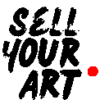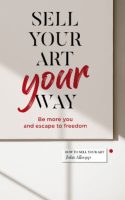Hi again
I’ve written a couple of posts in this ‘series’ now, one was about how, as an artist, to get onto page one of Google. The other was about how to get the right people to like you when they find you.
Today I want to write about the final piece of the puzzle, which is how to take those ‘likes’ and turn them into buyers.
Just before I do, let me thank everyone who contacted me with feedback, it all absolutely helps and I really appreciate it.
And just to underline the power of this stuff. I made one change to an artist’s website recently, and doubled the average time people spent on their website. Twenty minutes it took me. They are only small-time but they have been getting 124 hours in a year, and now they are going to get 248 (and this directly relates to sales). Because I made their website one step easier to use.
Usability is a really big deal to me. If you have a website and you want people to come and visit and perhaps you have 10 people visit per day. If you know there’s something confusing on your website but you haven’t quite got around to fixing it. Or you know your website doesn’t work properly on mobile devices, but you haven’t fixed it. Every day, you are imposing your lack of action on 10 people. 10 people who you are trying to charm into liking you. You are tripping them up as they walk into your shop. That’s just not right.
The artist’s website I mentioned just now? That simple fix dramatically helped mobile engagement, visit duration from mobile users is up 3.43 times. Most people nowadays browse the Internet using a mobile device like a phone or tablet.
So let’s look at conversion, that is .. how do you take someone who is just visiting and encourage them to buy something without getting all sleazy and hating yourself?
First of all, you don’t just walk up to a stranger and ask them to marry you. If you’re feeling super brave you might ask for someone’s number, but it might be better if you knew they were single and were looking for a relationship. Sales is the same. We call it the value journey.
This breaks down the ‘sale’ into easy mini-steps.
There are people who have never heard of you. Your job is to find some people who have some resources, who are likely to like what you do and get their attention. You might do that, for instance, by sharing images on Pinterest, getting stories into the press (see earlier email), or getting exhibitions (the organiser will write to their mailing list about your show).
If you can get those people to stop and notice you, then you want them to click .. perhaps to your website. That’s sale 1.
Once on your website or looking at your social media, we want to give your visitor enough for them to decide that they like you and they want you to be able to pop into their lives every now and then. We want a ‘like’ or a ‘follow’. That’s sale 2.
So then, your social media followers, ideally we want to give them enough ongoing good stuff that they make the leap to sign up to your mailing list. That’s a bigger commitment. Sale 3.
Once on your mailing list, you’ll obviously keep them informed more closely about what’s happening, and ideally you’ll move people to making the next commitment. This might be a small purchase, maybe you print a calendar or make Christmas cards. Maybe you are looking for Patreon support. Or perhaps the commitment is that people on your mailing list come to your exhibition or open studio .. a time commitment. Sale 4.
People who follow you on social media, are on your mailing list, and who turn up to your exhibitions are clearly supporters. If they have wallspace and a bit of spare cash, they are ready to buy. Ensure that you have a wide range of prices so everyone can join in. The actual sale, that’s sale 5.
When someone buys, see if you can put together an upsell. I’ve made up this idea, but I’m thinking that one of the things people like about art is they get a connection with an artist. It’s pretty cool, to be able to say you are friends with an artist, or you know them personally.
And I did some work with an artist/graphic designer who reduces landscapes to blocks and bold shapes of colour as a vector graphic. When I saw him taking photographs of potential landscapes I felt like I could see the world like he does. It gave me a new way to be, a new way to appreciate the landscape I walk in.
So I made up this idea that perhaps, once or twice a year, you could fill up a local B&B and have a “be more artist” week where people are coming mostly for a break but you’ve sprinkled some ‘you’ in there. It’s not a painting retreat, but they can do that if they want and maybe you do have one day where you all go out. The week has plenty of time for people to do their own thing, but every other evening they gather at yours for food and just to get to know you socially, time limited so as to not tire you out. You’ll have been painting a piece which is timed to start at the start of the week, and be done by the end, that gives a discussion point. You’ll offer it for sale if anyone wants it. And so one day you might just walk around one of your favourite places and talk about what you see. And perhaps another day another local artist will take them somewhere else. Maybe you can get in an acoustic musician friend to do half an hour sometime. You know? Charge a lot for the week, but it’s a way for people to really be able to say they know you, and to get inside your head and understand the artist’s eye. Do it with a similar artist pal if you prefer to share the load.
That’s what I mean by an upsell .. something limited and expensive and special. Sale 6.
And of course, past customers are far more likely to buy, which would turn them into repeat customers. Sale 7.
If these people are really, truly in support of you, which they would seem to be, perhaps they could support you at a high level on Patreon. After all, you both want the same sort of world and if you are secure, you can help make it happen. Sale 8.
Look back over those sales steps. Can you see how artists can get to thinking their website doesn’t make sales, and so they don’t give it attention and it deteriorates and gets messy and hard to use and everything gets demotivated.
And can you see how actually, your website is at the centre of all of it?
So getting your website sorted can make a massive difference, because it motivates everything around it.
So let’s recap and look at the big picture.
I started the Artist SEO blog because I made an offer of SEO coaching (to help people get onto page one of Google) and a lot of artists responded. So I thought, right. OK then, let’s do this.
The golden rule of SEO (search engine optimisation) is “be fabulous”. That means sorting out your website, getting into cycles so people feel they’ll miss out if they don’t (do whatever), finding your audience and being clear what you are for (and hence where you are going).
It means moving people in baby steps along the route to buying, and buying big.
The big question is .. how?
It’s actually doing it. Making these changes. Getting motivated.
And the approach to this is .. small wins.
We find something you are comfortable about changing. Do that. Experience the lift. Look around for something else.
Like that website change I mentioned at the start that pretty much doubled this artist’s chance to make sales. Twenty minutes work, that’s all it was, to stop irritating people and start bringing them in.
So for those artists who would like to take that next step and actually start to get all this in place, I’m putting together a course.
It’s going to run for eight weeks, online, video, properly organised. We’re going to go through
- the principles,
- producing content,
- the search phrases that sell (to use on your website),
- how to build links,
- the key things to sort out on your website,
- ecommerce (selling things on your website),
- local SEO (it’s different), and
- leadership and building a fanbase.
It will be a resource you can keep referring back to as you develop your practice.
So just keep an eye out for the announcement, I’ll open up registration soon but just for a week and then I need to close the doors so we can all go through the course together.
I hope you’ll join me and so we can make all this come true for you.
Alright, until next time.
One love.
J

